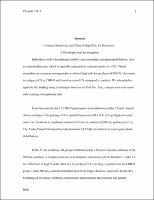Please use this identifier to cite or link to this item:
https://hdl.handle.net/20.500.12202/9037| Title: | Contrast sensitivity and clinical high risk for psychosis: A psychophysical investigation |
| Authors: | Zemon, Vance Pamela, Butler Herrera, Shaynna Gordon, James Swencionis, Charles Ifrah, Chloe |
| Keywords: | Physiological psychology |
| Issue Date: | 2023 |
| Publisher: | Yeshiva University |
| Citation: | Ifrah, C. (2023). Contrast sensitivity and clinical high risk for psychosis: A psychophysical investigation (Publication No. 29398115) [Doctoral dissertation, Yesiva University]. PDTG |
| Series/Report no.: | Ferkauf Doctoral Dissertations;Publication No. 29398115 |
| Abstract: | Individuals with schizophrenia exhibit visual anomalies and perceptual deficits, such as contrast detection, which is typically expressed as contrast sensitivity (CS). Visual anomalies are common among people at clinical high risk for psychosis (CHR-P). One study investigated CS in CHR-P and found increased CS compared to controls. We attempted to replicate this finding using a technique based on an iPad Pro. Also, comparisons were made with existing schizophrenia data. ¶ Fourteen controls and 12 CHR-P participants were administered the CS task: forced choice paradigm with gratings of five spatial frequencies (SFs, 0.41-13 cyc/deg) presented under two durations to emphasize transient (33-ms) or sustained (500-ms) pathway activity. The Audio-Visual Abnormalities Questionnaire (AVAQ) was utilized to assess perceptual disturbances. ¶ In the 33-ms condition, all groups exhibited nearly a lowpass function, whereas in the 500-ms condition, a bandpass function was obtained, consistent with the literature. Under 33- ms, difference in logCS, peak value at 1.6 cyc/deg to 0.41 cyc/deg, is greatest for the CHR-P group. Under 500-ms, controls benefitted most from longer duration, especially at mid-SFs. Modeling of excitatory/inhibitory mechanisms demonstrated that controls had greater excitation overall and greater increase in inhibition with increased duration. Linear mixed effects modeling revealed a Group x Temporal Condition interaction, F(1,234) = 5.008, p = .026. Positive correlations of logCS with AVAQ scores were obtained at the lowest SF, 500-ms for the CHR-P group (AVAQ total, r = .62, p = .04; visual processing subscale, r = .67, p = .03); negative correlations were obtained for logCS at 6.5 cyc/deg, 500-ms (AVAQ total, r = -.60, p = .04; visual processing subscale, r = -.61, p = .04). ¶ CS enhancement at low-SF in the CHR-P group was associated with perceptual disturbances, suggesting a deficit in lateral inhibition. A differential effect on CS with duration indicated possible concomitant effects on neural integration. CHR-P relative loss of CS at mid-SFs suggests dysfunction in ganglion cells tuned to mid-SFs which play a critical role in facial recognition and expression. These deficits are associated with other perceptual disturbances and psychotic-like symptoms. Additional research is needed to investigate CS in a larger sample, adjusting for medication. |
| Description: | Doctoral dissertation, PhD / Open Access |
| URI: | https://hdl.handle.net/20.500.12202/9037 |
| Appears in Collections: | Ferkauf Graduate School of Psychology: Doctoral Dissertations |
Files in This Item:
| File | Description | Size | Format | |
|---|---|---|---|---|
| Ifrah Chloe Dissertation Final 2023 Open Access.pdf | 1.24 MB | Adobe PDF |  View/Open |
This item is licensed under a Creative Commons License

